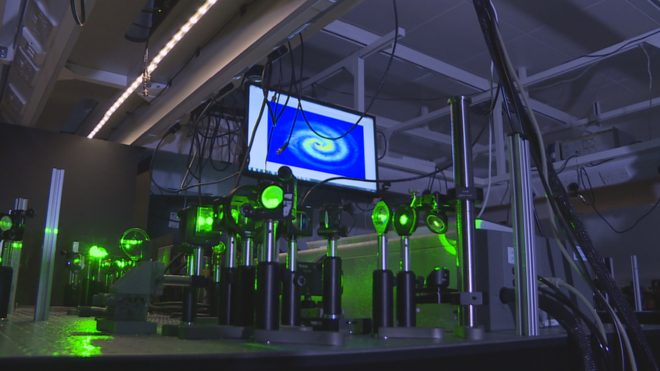Researchers at Heriot-Watt University in Edinburgh have built their own “black hole” in the laboratory.
The team has done it to prove a theory that huge amounts of energy can be harvested from a spinning black hole.
It is almost 50 years since physicist Professor Roger Penrose suggested an alien civilisation might be able to capture energy from one.
Now Heriot-Watt’s Extreme Light Group are trying to create the Penrose Mechanism here on Earth.
Led by Prof Daniele Faccio, the researchers built the experiment by twisting laser light into a vortex.
Happily for homeowners on the western edge of Edinburgh, this process just simulates the real behaviour of a black hole.
The real thing is like a gigantic cosmic plughole.
The gravitational pull of a black hole is so strong, everything goes down the drain. Not even light can escape.
In Penrose’s theory, the vortex will swallow almost everything. But the stuff that escapes will pick up more energy from the black hole’s spin as it skims past.
The simulated black hole is an intricate tracery of laser beams, lenses and mirrors.
It was costly to build, but at the heart of it is a short piece of copper pipe with standard brass plumbing fittings at either end.
Prof Faccio is proud that this part of the experiment only cost a couple of quid from a hardware store.
Filled with a graphene and liquid medium, this is where the action is, or will be.
If the Penrose Mechanism works, light will glance off the edge of the vortex.
Some will vanish down the “drain”. But some will dart away, picking up energy from the rotational force.
In theory, up to 29% of a black hole’s energy could be extracted before the spinning stops.
But according to Professor Faccio, we should be able to pull off a similar process on Earth without having to go anywhere near a real black hole.
“The beauty of this physics,” he says, “is that it’s so generic it can be applied to nearly anything that’s in rotation.
“There’s something magical about rotation.
“Rotating objects seem to behave differently than any other objects that are not rotating.”
The Heriot-Watt team is collaborating with researchers at Nottingham University. There they are using water instead of light, making the plughole an even closer analogy.
But the principle is the same: bounce things off the vortex and we could see small waves go in and much bigger waves come out.
Spinning vortex
It has taken three years to build the simulated black hole in Edinburgh.
Now the government’s Engineering and Physical Sciences Research Council is providing more funding to try to prove Penrose’s theory can be applied in the real world.
It could one day lead to new energy sources – a spin-off from a spinning vortex.
It can take years for technology to catch up with a big idea.
Peter Higgs waited half a century for researchers to build the Large Hadron Collider that found the Boson he had predicted.
The international team behind the Advanced Ligo detectors reported the discovery of gravitational waves this year – a century after Einstein said they would be there.
The Penrose Mechanism could be next.
Source: BBC News

































Leave a Comment
You must be logged in to post a comment.